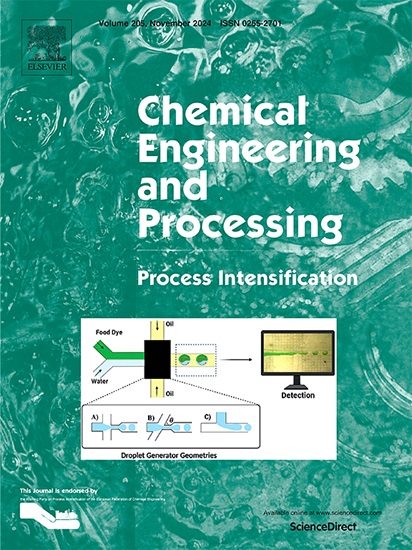Conjugate heat transfer simulation and additional thermal resistance analysis in pillow plate heat exchangers
IF 3.8
3区 工程技术
Q3 ENERGY & FUELS
Chemical Engineering and Processing - Process Intensification
Pub Date : 2025-06-11
DOI:10.1016/j.cep.2025.110407
引用次数: 0
Abstract
Pillow plate heat exchanger (PPHE) is a highly efficient heat exchanger element. The precise application of PPHE to heat exchanger scenarios can make a quantum leap in the field of heat exchangers. In this paper, we first added some missing power-law model relationships in the PPHE model. Including heat transfer and flow resistance coefficient of external flow channel, and heat transfer and resistance coefficient of non-circular welding spot models, which help to expand the heat transfer elements of welded plate heat exchangers. The focus of this paper is to investigate the heat transfer behavior more in line with the actual heat transfer process through conjugate convective heat transfer simulations. It is found that, in addition to the internal channel thermal resistance, outer channel thermal resistance, wall thermal resistance and fouling thermal resistance that exist in conventional heat exchangers, an additional thermal resistance exists in PPHE. The relationship between the magnitude of the additional thermal resistance and the Reynolds number of the flow in the inner channel outer channel can be represented by a power law model. This paper analyses in detail the causes of this additional thermal resistance, which will provide more accurate guidance for the design of PPHE heat exchangers.

枕板式换热器的共轭传热模拟及附加热阻分析
枕板式换热器(PPHE)是一种高效的换热器元件。PPHE在换热器场景中的精确应用可以使换热器领域发生巨大的飞跃。在本文中,我们首先在PPHE模型中加入了一些缺失的幂律模型关系。包括外流道的传热和流动阻力系数,以及非圆形焊点模型的传热和流动阻力系数,这有助于扩展焊接板式换热器的传热元件。本文的重点是通过共轭对流换热模拟来研究更符合实际换热过程的换热行为。研究发现,除了常规换热器存在的内通道热阻、外通道热阻、壁面热阻和污垢热阻外,PPHE还存在额外的热阻。附加热阻大小与内通道外通道流动雷诺数之间的关系可以用幂律模型表示。本文详细分析了该附加热阻产生的原因,为PPHE换热器的设计提供更准确的指导。
本文章由计算机程序翻译,如有差异,请以英文原文为准。
求助全文
约1分钟内获得全文
求助全文
来源期刊
CiteScore
7.80
自引率
9.30%
发文量
408
审稿时长
49 days
期刊介绍:
Chemical Engineering and Processing: Process Intensification is intended for practicing researchers in industry and academia, working in the field of Process Engineering and related to the subject of Process Intensification.Articles published in the Journal demonstrate how novel discoveries, developments and theories in the field of Process Engineering and in particular Process Intensification may be used for analysis and design of innovative equipment and processing methods with substantially improved sustainability, efficiency and environmental performance.

 求助内容:
求助内容: 应助结果提醒方式:
应助结果提醒方式:


